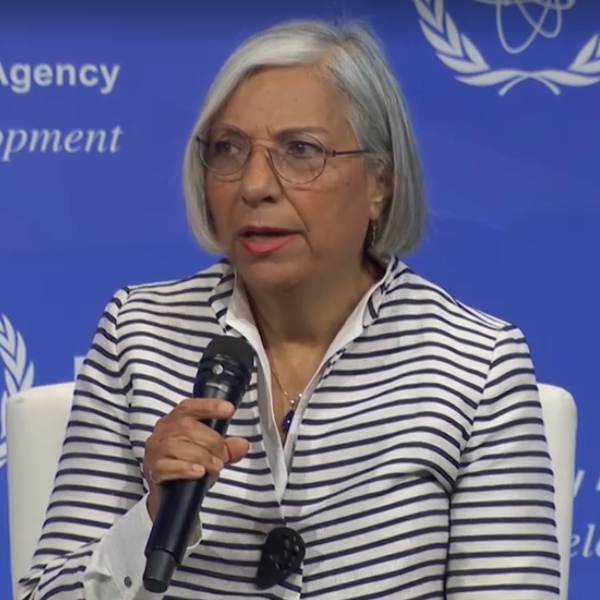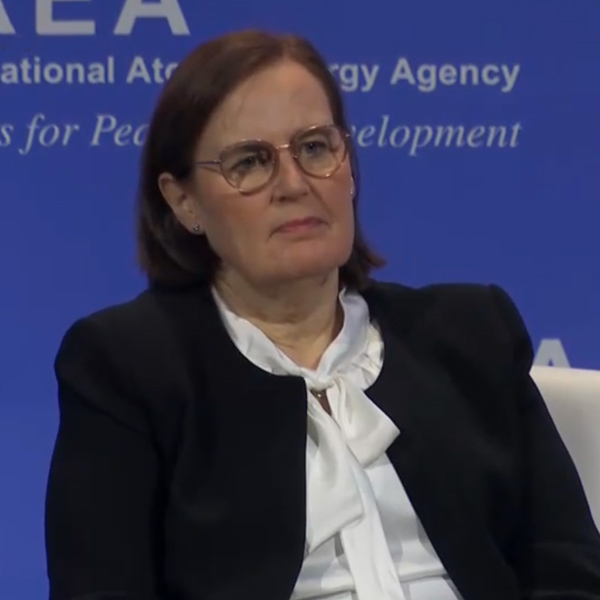WASHINGTON — The nuclear industry is out to change the conventional wisdom on building new nukes — specifically that such projects are always late, over budget and do not perform as expected.
The way forward, according to a panel of nuclear safety regulators at the International Atomic Energy Agency’s Ministerial Conference last week, will require harmonization of standards, international collaboration and a strong sense of urgency.
“Regulators are often perceived as barriers to efficient deployment of new-build [projects] and the adoption of new technologies and innovation,” said Mark Foy, chief executive and chief nuclear inspector of the UK Office for Nuclear Regulation. “I think it’s time for regulators to actually bust that myth.”
 Rumina Velshi, Canadian Nuclear Safety Commission | IAEA
Rumina Velshi, Canadian Nuclear Safety Commission | IAEAWith the U.K. targeting 24 GW of new nuclear by 2050, “the future will see innovative technologies, innovative operating regimes and new organizational designs,” Foy said in his opening remarks as both panel moderator and participant. “As [regulators], we welcome these and are beginning to look at our approach and criteria for assessment and for licensing, and how they need to evolve in this new world.”
“A global industry will require global solutions,” he said, with alignment — or “harmonization” — of standards between countries a major topic of discussion within the industry.
Rumina Velshi, CEO of Canada’s Nuclear Safety Commission, agreed that as new technologies such as small modular reactors (SMRs) are rolled out, countries will need to develop a common framework that is technology-inclusive, performance-based and risk-informed. Achieving the scale and speed needed to meet climate goals will also mean short-term standardization of SMR design, Velshi said.
“SMRs will only work if we’ve got a reasonable number of technologies, not the more than 80 or 90 being considered,” she said. “Governments and industry [must] come together with a reasonable set of technologies … and standard designs that can deploy globally.”
 Christopher T. Hanson, NRC | IAEA
Christopher T. Hanson, NRC | IAEAWhile agreeing with Velshi on the need for whittling down the “plethora of new designs,” Christopher T. Hanson, chair of the U.S. Nuclear Regulatory Commission, argued for striking “a balance between harmonization and sovereign, national responsibilities. After all, each of us regulators will be regulating the reactors within our own borders and are responsible to our citizens.”
The NRC in August issued a design certification for the NuScale SMR to be built at the Idaho National Laboratory and is now reviewing the Kairos Hermes advanced reactor planned for Tennessee, Hanson said. He also stressed the need for “the continued and ongoing safe operation of the current fleet, overseen by strong, technically competent and independent regulators.”
Liisa Heikinheimo, deputy director general of Finland’s Ministry of Economic Affairs and Employment, also talked about the need for speed and flexibility in permitting processes as nuclear technologies continue to evolve.
Finland has set an aggressive goal of 2035 for carbon neutrality, Heikinheimo said, and SMRs will be needed “not only for electricity production but also to produce heat. This is a new feature, and it should be understood well from different angles. We need to build, most probably, units closer to cities and to be more flexible in operations to be compatible with renewables.”
 Lisa Heikinheimo, Finland | IAEA
Lisa Heikinheimo, Finland | IAEARepresenting the industry voice on the panel, Jay Wileman, CEO of GE Hitachi Nuclear Energy, also called for a new narrative for nuclear, saying that the industry must counter its late and over-budget profile. The only new reactors built in the U.S. in three decades, Georgia Power’s Vogtle plants, are years late, with an estimated cost of $30 billon, more than double the original cost estimate of $14 billion. The utility announced that one of the reactors started to load fuel in October and could begin operation in the first quarter of 2023.
Moving forward, the industry must be more competitive, Wileman said. “We have to come in with a design that’s at the right cost. To do that, you have to have a standard plant, a repeatable one that can be taken globally from one country to another, one regulatory overview to another, without redesigning every time.”
“You have to design to cost,” and deliver both on time and on performance, he said.
GE Hitachi is working with regulators in the U.S. and Canada on the permitting for its BWRX-300 SMR, which has been chosen for projects by TVA, Ontario Power Generation and SaskPower in Saskatchewan.
Clean, Firm, Dispatchable
The emerging international footprint for nuclear is now, at least within the industry, a given. According to multiple speakers at the IAEA conference, keeping climate change to 1.5 degrees Celsius and achieving worldwide carbon neutrality by 2050 will not be possible without the clean, firm, dispatchable power nuclear can provide.
The change in attitudes toward nuclear around the world “is palpable,” said Rafael Mariano Grossi, director general of the IAEA, in his opening remarks at the event on Wednesday. “Countries, important countries, at some point in their contemporary history thought nuclear energy would no longer be part of their energy mix, and we see countries reversing those decisions or decisively moving into nuclear because we have to be led by science, by economically feasible decisions and not by ideology.”
With nations in Africa and Latin America increasingly looking at nuclear, Grossi said, governments must “choose the right technologies, the right partners and provide the right framework for nuclear expansion.”
William D. Magwood IV, director general of the Nuclear Energy Agency of the Organization for Economic Cooperation and Development (OECD), said nuclear generation — both for electricity and process heat for heavy industry — will have to triple by 2050.
Announcements during and following the conference add to a growing narrative around nuclear as a core technology for energy security and economic development in the U.S. and worldwide.
Energy Secretary Jennifer Granholm closed the conference on Friday with an announcement that Poland had selected a U.S. bid from Westinghouse for the country’s first nuclear reactor. The decision, Granholm said, “sends a clear message to Russia that the Atlantic alliance stands together to diversify our energy supply to strengthen climate cooperation and resist Russian weaponization of energy.”
On Thursday, TerraPower, the advanced nuclear company founded by Bill Gates, and PacifiCorp announced their plans to explore deploying TerraPower’s Natrium advanced reactor to five sites in the utility’s service territory by 2035. The two companies are collaborating on the federally funded Natrium demonstration plant being planned for Kemmerer, Wyoming, at the site of a coal plant slated for closure.
The White House on Monday also announced a new clean energy partnership with the United Arab Emirates, with the “full-scale implementation” of civil nuclear technology called out as a key provision of the partnership framework.
‘High-quality Inputs’
While the U.S. continues to lead the world in nuclear power generation, China has moved into second place with 54 reactors currently in operation and another 22 under construction, according to the World Nuclear Association. As with other clean technologies, China has also developed a strong domestic supply chain, putting pressure on U.S. competitiveness in international markets.
Regulators at the IAEA conference faced questions about how long safety permitting should take and what companies and regulators need to do to keep projects on track.
Hanson said the length of the permitting cycle “depends on the quality of the input — if we have substantive pre-application engagement, if we get high-quality inputs. What does ‘high-quality inputs’ mean? It means show your work. Don’t just assert safety, show us; prove it in your application.”
Complexity and maturity of technology are other key factors, he said. One recent application, for a low-power reactor used to produce isotopes at a medical facility in Wisconsin, was reviewed in 24 months, Hanson said,
The NRC also recently released the draft environmental impact statement for the Kairos Hermes advanced reactor, 12 months after the project was first submitted. A final EIS is scheduled for the end of September 2023, according to the NRC website.
Velshi said Canada is also aiming for a 24-month turnaround for new advanced reactors.
At the same time, license extensions have become a major focus for U.S. and Canadian regulators, with projects in both countries looking to extend plant life to 60 or even 80 years. In the U.S., the NRC looks for “a rigorous and data-focused aging management plan … to ensure that as that plant proceeds into its longer life, it is doing so safety,” Hanson said.
The refurbishments needed for relicensing are often “massive projects that are probably equivalent to new-build projects,” Velshi said. The nuclear sector’s ability to deliver these projects on time and safely can provide “remarkable value in building confidence” for the public, investors and policy makers, she said.
Wileman agreed with the regulators on the need for high-quality applications, but he said, companies like GE Hitachi need “very good pre-submission discussions … really being able to go shoulder-to-shoulder and work the process collaboratively and make sure the dialogue is there; make sure everyone has a sense of urgency.”
“It’s important that the regulators and the industry understand the ambitions of one another and perhaps the challenges that each [faces],” Foy said. “But you can’t do it in isolation. You do have to come together and work on that end solution.”



